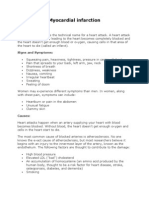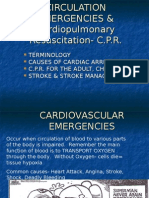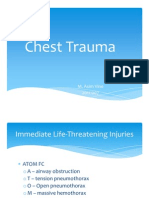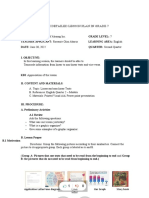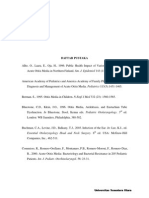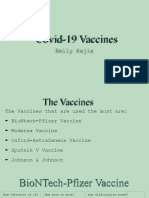Cardiac Tamponade
Cardiac Tamponade
Uploaded by
Rahmi Fatma SariCopyright:
Available Formats
Cardiac Tamponade
Cardiac Tamponade
Uploaded by
Rahmi Fatma SariOriginal Title
Copyright
Available Formats
Share this document
Did you find this document useful?
Is this content inappropriate?
Copyright:
Available Formats
Cardiac Tamponade
Cardiac Tamponade
Uploaded by
Rahmi Fatma SariCopyright:
Available Formats
Background
Cardiac tamponade is a clinical syndrome caused by the accumulation of fluid in the pericardial
space, resulting in reduced ventricular filling and subsequent hemodynamic compromise. The
condition is a medical emergency, the complications of which include pulmonary edema, shock, and
death. (See Pathophysiology, tiology, and Prognosis.!
The overall mortality risk depends on the speed of diagnosis, the treatment provided, and the
underlying cause of the tamponade. "ntreated, the condition is rapidly and universally fatal (see the
image below!. (See Presentation, #orkup, Treatment, and $edication.!
This anteroposterior%view chest radiograph shows a massive, bottle%shaped heart and
conspicuous absence of pulmonary vascular congestion. &eproduced with permission from Chest, '(()* '+(*,-..
Pathophysiology
The pericardium, which is the membrane surrounding the heart, is composed of - layers. The thicker
parietal pericardium is the outer fibrous layer/ the thinner visceral pericardium is the inner serous
layer. The pericardial space normally contains -+%.+m0 of fluid.
&eddy et al describe 1 phases of hemodynamic changes in tamponade.
2'3
Phase 4 % The accumulation of pericardial fluid causes increased stiffness of the ventricle,
requiring a higher filling pressure/ during this phase, the left and right ventricular filling pressures are
higher than the intrapericardial pressure
Phase 44 % #ith further fluid accumulation, the pericardial pressure increases above the
ventricular filling pressure, resulting in reduced cardiac output (see the Cardiac 5utput calculator!
Phase 444 % 6 further decrease in cardiac output occurs, which is due to the equilibration of
pericardial and left ventricular (07! filling pressures
Pericardial effusions, which cause cardiac tamponade, can be serous, serosanguineous,
hemorrhagic, or chylous.
The underlying process for the development of tamponade is a marked reduction in diastolic filling,
which results when transmural distending pressures become insufficient to overcome increased
intrapericardial pressures. Tachycardia is the initial cardiac response to these changes to maintain the
cardiac output.
Systemic venous return is also altered during tamponade. 8ecause the heart is compressed
throughout the cardiac cycle due to the increased intrapericardial pressure, systemic venous return is
impaired and right atrial and right ventricular collapse occurs. 8ecause the pulmonary vascular bed is
a vast and compliant circuit, blood preferentially accumulates in the venous circulation, at the e9pense
of 07 filling. This results in reduced cardiac output and venous return.
The amount of pericardial fluid needed to impair diastolic filling of the heart depends on the rate of
fluid accumulation and the compliance of the pericardium. &apid accumulation of as little as '.+m0 of
fluid can result in a marked increase in pericardial pressure and can severely impede cardiac output,
2-3
whereas '+++ m0 of fluid may accumulate over a longer period without any significant effect on
diastolic filling of the heart. This is due to adaptive stretching of the pericardium over time. 6 more
compliant pericardium can allow considerable fluid accumulation over a longer period without
hemodynamic insult.
Etiology
:or all patients, malignant diseases are the most common cause of pericardial tamponade. 6mong
etiologies for tamponade, $erce et al reported the following incidence rates*
$alignant diseases % 1+%)+; of cases
"remia % '+%'.; of cases
4diopathic pericarditis % .%'.;
4nfectious diseases % .%'+;
6nticoagulation % .%'+;
Connective tissue diseases % -%);
<ressler or postpericardiotomy syndrome % '%-;
Tamponade can occur as a result of any type of pericarditis. Pericarditis can result from the
following
213
*
=uman immunodeficiency virus (=47! infection
4nfection % 7iral, bacterial (tuberculosis!, fungal
<rugs % =ydrala>ine, procainamide, isonia>id, mino9idil
Postcoronary intervention % 4e, coronary dissection and perforation
6cupuncture
2?3
Postcardiac percutaneous procedures % 4ncluding mitral valvuloplasty, atrial septal defect
(6S<! closure, left atrial appendage occlusion
Trauma to the chest
Cardiovascular surgery % Postoperative pericarditis
2.3
Postmyocardial infarction % :ree wall ventricular rupture, <ressler syndrome
Connective tissue diseases % Systemic lupus erythematosus, rheumatoid arthritis,
dermatomyositis
&adiation therapy to the chest
4atrogenic
2)3
% 6fter sternal biopsy, transvenous pacemaker lead implantation,
pericardiocentesis, or central line insertion
"remia
6nticoagulation treatment
4diopathic pericarditis
Complication of surgery at the esophagogastric @unction % g, antireflu9 surgery
Pneumopericardium % <ue to mechanical ventilation or gastropericardial fistula
=ypothyroidism
Still disease
<uchenne muscular dystrophy
Type 6 aortic dissection
Epidemiology
Occurrence in the United States
The incidence of cardiac tamponade is - cases per '+,+++ population in the "nited States.
6ppro9imately -; of penetrating in@uries are reported to result in cardiac tamponade.
Sex- and age-related demographics
4n children, cardiac tamponade is more common in boys than in girls, with a male%to%female ratio of
A*1. 4n adults, cardiac tamponade appears to be slightly more common in men than in women. 6 male%
to%female ratio of '.-.*' was observed at the authorBs referral center, based on the 4nternational
Classification of <iseases (4C<! code ?-1.(. =owever, a male%to%female ratio of '.A*' was observed
at another level ' trauma center.
Cardiac tamponade related to trauma or =47 is more common in young adults, whereas tamponade
due to malignancy andCor renal failure occurs more frequently in elderly individuals.
Prognosis
Cardiac tamponade is a medical emergency. The prognosis depends on prompt recognition and
management of the condition and the underlying cause of the tamponade. "ntreated, cardiac
tamponade is rapidly and universally fatal.
4n addition to treatment for the tamponade, all patients should also receive treatment for the
conditionDs underlying cause in order to prevent recurrence.
4n a study of patients with cardiac tamponade, Cornily et al reported a '%year mortality rate of A)..;
in patients whose tamponade was caused by malignant disease, compared with '1.1; in patients
with no malignant disease. The investigators also noted a median survival of '.+ days in patients with
malignant disease.
2A3
Proceed to Clinical Presentation
History
Symptoms vary with the acuteness and underlying cause of the tamponade. Patients with acute
tamponade may present with dyspnea, tachycardia, and tachypnea. Cold and clammy e9tremities
from hypoperfusion are also observed in some patients.
6 comprehensive review of the patientBs history usually helps in identifying the probable etiology of a
pericardial effusion. The following may be noted*
Patients with systemic or malignant disease present with weight loss, fatigue, or anore9ia
Chest pain may be the presenting symptom in patients with pericarditis or myocardial
infarction
$usculoskeletal pain or fever may be present in patients with an underlying connective tissue
disorder
6 history of renal failure can lead to a consideration of uremia as the cause of pericardial
effusion
Careful review of a patientBs medications may indicate that drug%related lupus caused the
pericardial effusion
&ecent cardiovascular surgery, coronary intervention, or trauma can lead to the rapid
accumulation of pericardial fluid and tamponade
2.3
&ecent pacemaker lead implantation or central venous catheter insertion can lead to the rapid
accumulation of pericardial fluid and tamponade
2,3
Consider =47%related pericardial effusion and tamponade if the patient has a history of
intravenous (47! drug abuse or opportunistic infections
4nquire about chest wall radiation % 4e, for lung, mediastinal, or esophageal cancer
4nquire about symptoms of night sweats, fever, and weight loss, which may be indicative of
tuberculosis
Physical Examination
4n a retrospective study of patients with cardiac tamponade, the most common symptoms noted by
&oy et al were dyspnea, tachycardia, and elevated @ugular venous pressure.
2(3
vidence of chest wall
in@ury may be present in trauma patients.
Tachycardia, tachypnea, and hepatomegaly are observed in more than .+; of patients with cardiac
tamponade, and diminished heart sounds and a pericardial friction rub are present in appro9imately
one third of patients. Some patients may present with di>>iness, drowsiness, or palpitations. Cold,
clammy skin and a weak pulse due to hypotension are also observed in patients with tamponade.
Beck triad
<escribed in '(1., this comple9 of physical findings, also called the acute compression triad, refers to
increased @ugular venous pressure, hypotension, and diminished heart sounds. These findings result
from a rapid accumulation of pericardial fluid. This classic triad is usually observed in patients with
acute cardiac tamponade.
Pulsus paradoxus
Pulsus parado9us (or parado9ical pulse! is an e9aggeration (E'- mm =g or (;! of the normal
inspiratory decrease in systemic blood pressure.
To measure the pulsus parado9us, patients are often placed in a semirecumbent position/ respirations
should be normal. The blood pressure cuff is inflated to at least -+mm =g above the systolic pressure
and slowly deflated until the first Forotkoff sounds are heard only during e9piration.
6t this pressure reading, if the cuff is not further deflated and a pulsus parado9us is present, the first
Forotkoff sound is not audible during inspiration. 6s the cuff is further deflated, the point at which the
first Forotkoff sound is audible during both inspiration and e9piration is recorded.
4f the difference between the first and second measurement is greater than '- mm =g, an abnormal
pulsus parado9us is present.
The parado9 is that while listening to the heart sounds during inspiration, the pulse weakens or may
not be palpated with certain heartbeats, while S' is heard with all heartbeats.
6 pulsus parado9us can be observed in patients with other conditions, such asconstrictive pericarditis,
asthma, severe obstructive pulmonary disease, restrictive cardiomyopathy, pulmonary embolism,
rapid and labored breathing, and right ventricular infarction with shock.
6 pulsus parado9us may be absent in patients with markedly elevated 07 diastolic pressures, atrial
septal defect, pulmonary hypertension, aortic regurgitation, low%pressure tamponade, or right heart
tamponade.
Kussmaul sign
This was described by 6dolph Fussmaul as a parado9ical increase in venous distention and pressure
during inspiration. The Fussmaul sign is usually observed in patients with constrictive pericarditis, but
it is occasionally is observed in patients with effusive%constrictive pericarditis and cardiac tamponade.
Ewart sign
6lso known as the Pins sign, this is observed in patients with large pericardial effusions. 4t is
described as an area of dullness, with bronchial breath sounds and bronchophony below the angle of
the left scapula.
he y descent
The y descent is abolished in the @ugular venous or right atrial waveform. This is due to an increase in
intrapericardial pressure, preventing diastolic filling of the ventricles.
!ysphoria
8ehavioral traits such as restless body movements, unusual facial e9pressions, restlessness, and a
sense of impending death were reported by 4kematsu in about -); patients with cardiac tamponade.
2'+3
"ow-pressure tamponade
4n severely hypovolemic patients, classical physical findings such as tachycardia, pulsus parado9us,
and @ugular venous distention were infrequent. SagristG%Sauleda et al identified low%pressure
tamponade in -+; of patients with cardiac tamponade.
2''3
They also reported low%pressure tamponade
in '+; of large pericardial effusions.
Proceed to !i##erential !iagnoses
!iagnostic Considerations
arly diagnosis with a high inde9 of suspicion is necessary to minimi>e morbidity and mortality from
tamponade.
0arge pleural effusion
Cases of cardiac tamponade have been reported with large pleural effusions. The increased
intrapleural pressure resulting from large pleural effusions can be transmitted to the pericardial space
and impair ventricular filling, thus producing the hemodynamic equivalent of cardiac tamponade.
Tension pneumopericardium
The hemodynamic changes in tension pneumopericardium simulate acute cardiac tamponade.
Clinically, distant heart sounds, bradycardia, and shifting tympany occur over the precordium, and a
characteristic murmur, termed bruit de la roue de moulin, is heard. This is usually observed in infants
with mechanical ventilation but is also seen after sternal bone marrow aspiration, penetrating chest
wall in@ury, esophageal rupture, and bronchopericardial fistula.
&apid and labored breathing
0arge decreases in intrathoracic pressure with deep inspirations, often observed during respiratory
failure, can accentuate pulsus parado9us, simulating pericardial tamponade.
!i##erential !iagnoses
Cardiogenic Shock
Pericarditis, Constrictive
Pericarditis, Constrictive%ffusive
Pulmonary mbolism
Tension Pneumothora9
maging Studies
Chest radiography
Chest radiography findings may show cardiomegaly, a water bottleHshaped heart, pericardial
calcifications, or evidence of chest wall trauma. (See the image below.!
This anteroposterior%view chest radiograph shows a massive, bottle%shaped heart and
conspicuous absence of pulmonary vascular congestion. &eproduced with permission from Chest, '(()* '+(*,-..
6 bowed catheter sign on chest radiography in children after central venous catheter insertion may be
suggestive of tamponade.
2'-3
C scanning
Iold et al reported compression of the coronary sinus as observed through CT scanning as an earlier
marker for cardiac tamponade in ?); of patients.
2'13
Echocardiography
6lthough echocardiography provides useful information, cardiac tamponade is a clinical diagnosis.
The following may be observed with -%dimensional (-%<! echocardiography*
6n echo%free space posterior and anterior to the left ventricle and behind the left atrium % 6fter
cardiac surgery, a locali>ed, posterior fluid collection without significant anterior effusion may occur
and may readily compromise cardiac output
arly diastolic collapse of the right ventricular free wall (see the images below!
arly diastolic collapse of right ventricular free wall (subcostal view!.
arly diastolic collapse of right ventricular free wall (parasternal short%a9is
view at aortic valve!.
0ate diastolic compressionCcollapse of the right atrium (see the image below!
0ate diastolic collapse of right atrium (subcostal view!.
Swinging of the heart in its sac
07 pseudohypertrophy
4nferior vena cava plethora with minimal or no collapse with inspiration (see the image below!
<ilated inferior vena cava.
6 greater than ?+; relative inspiratory augmentation of right%side flow
6 greater than -.; relative decrease in inspiratory flow across the mitral valve
Conditions that may simulate pericardial effusion on -%< echocardiography include the following*
6 large left pleural effusion
6ny tumor surrounding the heart
$itral annular calcification
6 descending thoracic aorta
6 catheter in the right ventricle
6n enlarged left atrium
6n annular subvalvular 07 aneurysm
6 bronchogenic cyst
$pproach Considerations
6s previously stated, prompt diagnosis is key to reducing the mortality risk for patients with cardiac
tamponade. 6lthough cardiac tamponade is a clinical diagnosis, further assessment of the patientDs
condition and diagnosis of the underlying cause of the tamponade can be obtained through lab
studies, imaging studies, and electrocardiography.
chocardiography, for e9ample, can be used to visuali>e ventricular and atrial compression
abnormalities as blood cycles through the heart, while lab studies can demonstrate signs of
myocardial infarction, cardiac trauma, and infectious disease.
"a% Studies
The following studies aid in the assessment of patients with cardiac tamponade*
Creatine kinase and isoen>ymes % levels are elevated in patients with myocardial infarction
and cardiac trauma
&enal profile and complete blood count (C8C! with differential % These tests are useful in the
diagnosis of uremia and certain infectious diseases associated with pericarditis
Coagulation panel % The prothrombin time and activated partial thromboplastin time are useful
for determining bleeding risk during interventions, such as pericardial drainage andCor the placement
of pericardial windows
6ntinuclear antibody assay, erythrocyte sedimentation rate, and rheumatoid factor % 6lthough
nonspecific, results from these tests may give clues to a connective tissue disease predisposing to
the development of pericardial effusion.
=47 testing % 6ppro9imately -?; of all pericardial effusions are reported to be associated with
=47 infection
Purified protein derivative testing % This is used to diagnose tuberculosis, which is an
important and not uncommon cause of pericardial effusion and tamponade.
Electrocardiography
#ith a '-%lead electrocardiogram (see the image below!, the following findings suggest, but are not
diagnostic for, pericardial tamponade*
Sinus tachycardia
0ow%voltage J&S comple9es
lectrical alternans % 6lso observed during supraventricular and ventricular tachycardia
P& segment depression 6 '-%lead electrocardiogram showing
sinus tachycardia with electrical alternans. &eproduced with permission from Chest, '(()/ '+(*,-..
Electrical alternans
6lternation of J&S comple9es, usually in a -*' ratio, on electrocardiographic findings is called
electrical alternans. 4t is caused by movement of the heart in the pericardial space. lectrical alternans
is also observed in patients with myocardial ischemia, acute pulmonary embolism, and
tachyarrhythmias.
Pulse Oximetry
&espiratory variability in pulse%o9imetry waveform is noted in patients with pulsus parado9us. 4n a
small group of patients with tamponade, Stone et al noted increased respiratory variability in pulse%
o9imetry waveform in all patients.
2'?3
This finding should raise the suspicion for hemodynamic
compromise. 4n patients with atrial fibrillation, pulse%o9imetry may aid in detecting the presence of
pulsus parado9us.
Swan-&an' Catheteri'ation
8efore or after insertion of the Swan%Ian> catheter, the system must be >eroed after positioning the
transducer at the midpoint of the left atrium. Then calibrate the monitoring system. Prior to insertion,
test the balloon and flush all of the ports. Then insert the catheter into one of the ma@or veins.
6t a depth of -+ cm, inflate the balloon and slowly advance the catheter, while continuously
monitoring the pressure from the distal lumen. 6lways deflate the balloon before withdrawing the
Swan%Ian> catheter. The waveforms help to indicate the position of the catheter tip if fluoroscopy is
not readily accessible.
6t appro9imately the ?+%.+ cm mark, the wedge pressure is usually recorded. Secure the catheter
position, and obtain a chest radiograph to confirm the position.
4n tamponade, near equali>ation (within . mm =g! of the right atrial, right ventricular diastolic,
pulmonary arterial diastolic, and pulmonary capillary wedge pressure (reflecting left atrial pressure!
occurs. The right atrial pressure tracings display a prominent systolic x descent and abolished
systolic y descent.
8oltwood et al described the diastolic equali>ation of pulmonary capillary and right atrial pressures as
predominantly inspiratory/ this is known as the inspiratory traction sign.
2'.3
4t results from inspiratory
traction of the taut pericardium by the diaphragm.
Histologic (indings
5ccasionally, a pericardial biopsy is performed when the etiology of the pericardial effusion that
caused the tamponade is unclear. This is especially useful in cases of tuberculous pericardial
effusions, because cultures of the pericardial fluid in these cases rarely yield a positive result for
mycobacteria. =owever, granulomas seen on pericardial biopsy specimens are often seen in patients
with tuberculous pericarditis.
4n general, cytopathologic findings from pericardial fluid and histologic findings from pericardial biopsy
specimens depend on the underlying pathology. Cytologic e9amination identifies the etiopathologic
cause of tamponade in about A.; of cases.
2')3
Proceed to reatment ) *anagement
$pproach Considerations
Cardiac tamponade is a medical emergency. Preferably, patients should be monitored in an intensive
care unit. 6ll patients should receive the following*
59ygen
7olume e9pansion with blood, plasma, de9tran, or isotonic sodium chloride solution, as
necessary, to maintain adequate intravascular volume % SagristG%Sauleda et al noted significant
increase in cardiac output after volume e9pansion
2'A3
(see the Cardiac 5utput calculator!
8ed rest with leg elevation % This may help increase venous return
4notropic drugs (eg, dobutamine! % These can be useful because they increase cardiac output
without increasing systemic vascular resistance
Positive%pressure mechanical ventilation should be avoided because it may decrease venous return
and aggravate signs and symptoms of tamponade.
+npatient care
6fter pericardiocentesis, leave the intrapericardial catheter in place after securing it to the skin using
sterile procedure and attaching it to a closed drainage system via a 1%way stopcock. Periodically
check for reaccumulation of fluid, and drain as needed.
The catheter can be left in place for '%- days and can be used for pericardiocentesis. Serial fluid cell
counts can be useful for helping to discover an impending bacterial catheter infection, which could be
catastrophic. 4f the white blood cell (#8C! count rises significantly, the pericardial catheter must be
removed immediately.
6 Swan%Ian> catheter can be left in place for continuous monitoring of hemodynamics and to assess
the effect of reaccumulation of pericardial fluid. 6 repeat echocardiogram and a repeat chest
radiograph should be performed within -? hours.
Consultations
Consultations associated with cardiac tamponade can include the following*
=emodynamically stable patients % Cardiologist
=emodynamically unstable patients % Cardiologist, cardiothoracic surgeon
$cti,ity
4nitially, the patient should be on bed rest with leg elevation to increase the venous return. 5nce the
signs and symptoms of tamponade resolve, activity can be increased as tolerated.
(ollow-up
6 follow%up echocardiogram and chest radiograph should be performed at a monthly follow%up
e9amination to check for recurrent fluid accumulation.
Pericardiocentesis and Pericardiotomy
&emoval of pericardial fluid is the definitive therapy for tamponade and can be done using the
following 1 methods.
Emergency su%xiphoid percutaneous drainage
This is a life%saving bedside procedure. The sub9iphoid approach is e9trapleural/ hence, it is the
safest for blind pericardiocentesis. 6 ')% or ',%gauge needle is inserted at an angle of 1+%?.K to the
skin, near the left 9iphocostal angle, aiming towards the left shoulder. #hen performed emergently,
this procedure is associated with a reported mortality rate of appro9imately ?; and a complication
rate of 'A;.
Echocardiographically guided pericardiocentesis
This is often carried out in the cardiac catheteri>ation laboratory. The procedure is usually performed
from the left intercostal space. :irst, mark the site of entry based on the area of ma9imal fluid
accumulation closest to the transducer. Then, measure the distance from the skin to the pericardial
space. The angle of the transducer should be the tra@ectory of the needle during the procedure. 6void
the inferior rib margin while advancing the needle to prevent neurovascular in@ury. 0eave a ')%gauge
catheter in place for continuous drainage.
Percutaneous %alloon pericardiotomy
This can be performed using an approach similar to that for echo%guided pericardiocentesis, with the
balloon being used to create a pericardial window.
Surgical Care in Hemodynamically Unsta%le Patients
:or a hemodynamically unstable patient or one with recurrent tamponade, provide care as described
below.
Surgical creation o# a pericardial window
This involves the surgical opening of a communication between the pericardial space and the
intrapleural space. This is usually a sub9iphoidian approach, with resection of the 9iphoid. =owever, a
left para9iphoidian approach with preservation of the 9iphoid has been described.
2',3
5pen thoracotomy andCor pericardiotomy
2.3
may be required in some cases, and these should be
performed by an e9perienced surgeon.
-ecurrent cardiac tamponade or pericardial e##usion
Sclerosing the pericardium
This is a therapeutic option for patients with recurrent pericardial effusion or tamponade. Through the
intrapericardial catheter, corticosteroids, tetracycline, or antineoplastic drugs (eg, anthracyclines,
bleomycin! can be instilled into the pericardial space.
Pericardio-peritoneal shunt
4n some patients with malignant recurrent pericardial effusions, the creation of a pericardio%peritoneal
shunt helps to prevent recurrent tamponade.
Pericardiectomy
&esection of the pericardium (pericardiectomy! through a median sternotomy or left thoracotomy is
rarely required to prevent recurrent pericardial effusion and tamponade.
.ideo-$ssisted horascopic Procedure
4n a study of '. patients with cardiac tamponade, $onaco et al found that a modified, video%assisted
thoracoscopic procedure seemed to be a feasible treatment for the condition.
2'(3
"sing a right hemithoracic approach, the investigators employed a '.mm trocar on the fourth right
intercostal space on the anterior a9illary and a '+mm trocar on the seventh right intercostal space on
the median a9illary line.
"tili>ation of a .mm optic allowed - instruments, for the optic and for the endoscopic forceps, to be
employed simultaneously using ' trocar/ this left the second trocar available for dissecting scissors.
6ll patients underwent a pericardial resection equal to that achievable via an anterolateral
thoracotomy.
The pericardial effusion was effectively drained in all patients, with no intraoperative mortality or
perioperative morbidity encountered.
Proceed to *edication
*edication Summary
The role of medication therapy in cardiac tamponade is limited. 5ccasionally, inotropic agents that do
not increase peripheral vascular resistance, such as the synthetic catecholamine dobutamine, may be
used to increase cardiac output.
Cardio,ascular/ Other
Class Summary
8y stimulating beta%' receptors in the heart, these agents increase stroke volume and cardiac output.
7iew full drug information
!o%utamine
<obutamine is a synthetic catecholamine and a direct inotropic agent that stimulates cardiac beta%
receptors, with minimal increase in systemic vascular resistance.
You might also like
- Epidemiology MCQs For Entrance Examination of Master of Public HealthDocument33 pagesEpidemiology MCQs For Entrance Examination of Master of Public HealthBijay kumar kushwaha67% (12)
- Patofisiologi Shock CardiogenicDocument44 pagesPatofisiologi Shock CardiogenicGalih Arief Harimurti Wawolumaja100% (2)
- Cardiac Tamponade, A Simple Guide To The Condition, Diagnosis, Treatment And Related ConditionsFrom EverandCardiac Tamponade, A Simple Guide To The Condition, Diagnosis, Treatment And Related ConditionsNo ratings yet
- Cardiogenic ShockDocument6 pagesCardiogenic ShockhamadaelgenNo ratings yet
- Cardiac TestsDocument17 pagesCardiac TestsGiorgiana pNo ratings yet
- Asthma: A. DefinitionDocument6 pagesAsthma: A. DefinitionElvando SimatupangNo ratings yet
- Myocardial Infarction: Signs and SymptomsDocument5 pagesMyocardial Infarction: Signs and SymptomsKelly OstolNo ratings yet
- Thyroid CrisisDocument11 pagesThyroid CrisisKoka KolaNo ratings yet
- Cardiac Enzyme StudiesDocument4 pagesCardiac Enzyme StudiesDara VinsonNo ratings yet
- CABGDocument25 pagesCABGkingafridiNo ratings yet
- Systemic Inflammatory ResponseDocument2 pagesSystemic Inflammatory Responsesmithaanne20016923No ratings yet
- Pericarditis NCLEX Review: Serous Fluid Is Between The Parietal and Visceral LayerDocument2 pagesPericarditis NCLEX Review: Serous Fluid Is Between The Parietal and Visceral LayerlhenNo ratings yet
- PacemakerDocument13 pagesPacemakeralainzkie100% (2)
- Acute Pulmonary EdemaDocument5 pagesAcute Pulmonary Edemaoctaviana_simbolonNo ratings yet
- Cardiac AssessmentDocument48 pagesCardiac AssessmentRatheesh NathNo ratings yet
- Central Venous Catheter - StatPearls - NCBI BookshelfDocument11 pagesCentral Venous Catheter - StatPearls - NCBI Bookshelfsafrina100% (1)
- Terminology Causes of Cardiac Arrest C.P.R. For The Adult, Child & Baby Stroke & Stroke ManagementDocument28 pagesTerminology Causes of Cardiac Arrest C.P.R. For The Adult, Child & Baby Stroke & Stroke Managementbusiness911No ratings yet
- Caronary Artery Disease & Congestive Heart Failure: Margaret Xaira R. Mercado RNDocument32 pagesCaronary Artery Disease & Congestive Heart Failure: Margaret Xaira R. Mercado RNMargaret Xaira Rubio MercadoNo ratings yet
- Thoracic Injuries 1Document32 pagesThoracic Injuries 1awais mpNo ratings yet
- Continuous Renal Replacement TherapyDocument38 pagesContinuous Renal Replacement Therapyanju rachel joseNo ratings yet
- Cardiogenic ShockDocument20 pagesCardiogenic Shockanimesh pandaNo ratings yet
- Cardiogenic ShockDocument27 pagesCardiogenic ShockIgor StefanetNo ratings yet
- Central Venous PressureDocument8 pagesCentral Venous PressureJen GarzoNo ratings yet
- Heart Disease Teaching PlanDocument16 pagesHeart Disease Teaching Planapi-554096544No ratings yet
- Precautions With Diabetic Patients Undergoing SurgeryDocument6 pagesPrecautions With Diabetic Patients Undergoing SurgeryErvin Kyle OsmeñaNo ratings yet
- CardiomyopathyDocument8 pagesCardiomyopathyKarisaNo ratings yet
- Supraventricular TachycardiaDocument9 pagesSupraventricular TachycardiaclubsanatateNo ratings yet
- Cerebrovascular Accident (CVA)Document71 pagesCerebrovascular Accident (CVA)nur muizzah afifah hussin100% (1)
- Antianginal DrugsDocument14 pagesAntianginal DrugsDRABHIJITNo ratings yet
- Asthma and Status AsthmaticusDocument19 pagesAsthma and Status Asthmaticussharon mogambiNo ratings yet
- Heart FailureDocument39 pagesHeart FailureMuhammad AsifNo ratings yet
- 7 Pulmonary EdemaDocument10 pages7 Pulmonary Edemaomar kmr97No ratings yet
- Cerebrovascular AccidentDocument30 pagesCerebrovascular AccidentJaydee Dalay100% (2)
- Malabsorption Syndrome Malaika NaseerDocument10 pagesMalabsorption Syndrome Malaika NaseerEntertainment MoviesNo ratings yet
- Systemic Inflammatory Response SyndromeDocument12 pagesSystemic Inflammatory Response SyndromeninapotNo ratings yet
- Pulmonary EmbolismDocument80 pagesPulmonary EmbolismVarun B Renukappa100% (2)
- Chronic Obstructive Pulmonary Disease COPDDocument25 pagesChronic Obstructive Pulmonary Disease COPDKat OrtegaNo ratings yet
- Upper GI Bleed - SymposiumDocument38 pagesUpper GI Bleed - SymposiumSopna ZenithNo ratings yet
- What Is ICU PsychosisDocument6 pagesWhat Is ICU PsychosisAngelicaMarieRafananNo ratings yet
- Unstable Angina PectorisDocument34 pagesUnstable Angina PectoriserinmowokaNo ratings yet
- Post Resus CareDocument35 pagesPost Resus Caredrjaikrish100% (1)
- Bronchial AsthmaDocument25 pagesBronchial AsthmaKamil HannaNo ratings yet
- Post Operative HemorrhageDocument16 pagesPost Operative Hemorrhagenishimura89No ratings yet
- Cardiogenic Shock Patofisiologi and TreatmentDocument40 pagesCardiogenic Shock Patofisiologi and TreatmentRichi Aditya100% (1)
- Nursing Management: Nursing Management: Acute Kidney Injury and Chronic Kidney DiseaseDocument22 pagesNursing Management: Nursing Management: Acute Kidney Injury and Chronic Kidney Diseasedian rachmat saputroNo ratings yet
- Muscle Strength TestingDocument3 pagesMuscle Strength TestingGiselle Chloe Baluya ico100% (1)
- Coronary Artery Disease CAD PathophysiologyDocument5 pagesCoronary Artery Disease CAD PathophysiologyKusum RoyNo ratings yet
- Chest InjuriesDocument19 pagesChest InjuriesAbdi Kumala100% (1)
- Septic ShockDocument16 pagesSeptic ShockGelo JvrNo ratings yet
- Diabetic Ketoacidosis Acute Management: A State of Absolute Insulin BankruptcyDocument24 pagesDiabetic Ketoacidosis Acute Management: A State of Absolute Insulin BankruptcyGwEn LimNo ratings yet
- Arianna Mabunga BSN-3B Urinary Diversion DeffinitionDocument5 pagesArianna Mabunga BSN-3B Urinary Diversion DeffinitionArianna Jasmine Mabunga0% (1)
- Pleural EffusionDocument3 pagesPleural EffusionEjie Boy IsagaNo ratings yet
- Cardiogenic Shock: Sparsh Goel 77Document28 pagesCardiogenic Shock: Sparsh Goel 77Sparsh GoelNo ratings yet
- Pleural Fluid AnalysisDocument15 pagesPleural Fluid AnalysisNatalie Sarah MoonNo ratings yet
- Heart TransplantationDocument10 pagesHeart TransplantationNajmi Leila SepyanisaNo ratings yet
- Pulmonary Embolism Is A Common and Potentially Lethal ConditionDocument13 pagesPulmonary Embolism Is A Common and Potentially Lethal ConditionJasleen KaurNo ratings yet
- Chest Trauma FinalDocument50 pagesChest Trauma FinalAsim Siddiq VineNo ratings yet
- Thrombolytic TherapyDocument16 pagesThrombolytic TherapyAnonymous nrZXFwNo ratings yet
- Ebstein Anomaly, A Simple Guide To The Condition, Diagnosis, Treatment And Related ConditionsFrom EverandEbstein Anomaly, A Simple Guide To The Condition, Diagnosis, Treatment And Related ConditionsNo ratings yet
- A Simple Guide to Hypovolemia, Diagnosis, Treatment and Related ConditionsFrom EverandA Simple Guide to Hypovolemia, Diagnosis, Treatment and Related ConditionsNo ratings yet
- A Simple Guide to Circulatory Shock, Diagnosis, Treatment and Related ConditionsFrom EverandA Simple Guide to Circulatory Shock, Diagnosis, Treatment and Related ConditionsNo ratings yet
- Hig Science Api 00051Document16 pagesHig Science Api 00051suggyNo ratings yet
- Milk and Milk ProductdDocument7 pagesMilk and Milk Productdjobsonsaji8No ratings yet
- CCM 3226 Primary Health - 1Document3 pagesCCM 3226 Primary Health - 1lydiacherotich7496No ratings yet
- Soldotna: (907) 714-4418 Fax (907) 714-4971: 250 Hospital Place, Soldotna, AK 99669Document1 pageSoldotna: (907) 714-4418 Fax (907) 714-4971: 250 Hospital Place, Soldotna, AK 99669JJ JovNo ratings yet
- Lesson Plan in English Transcode Linear To Non Linear and Vice VersaDocument5 pagesLesson Plan in English Transcode Linear To Non Linear and Vice VersaRoneca BatucanNo ratings yet
- Collier Et Al 2021 ENFERMEDADES EEUUDocument10 pagesCollier Et Al 2021 ENFERMEDADES EEUUMaiRa Quiroz CNo ratings yet
- Acute Febrile IllnessesDocument54 pagesAcute Febrile IllnessesfraolNo ratings yet
- Biology AssignmentDocument4 pagesBiology AssignmentIndiNo ratings yet
- Literature ReviewDocument4 pagesLiterature ReviewJan Aron Cyril LisingNo ratings yet
- Daftar Pustaka: Essential Otolaryngology Head and Neck Surgery. 8Document3 pagesDaftar Pustaka: Essential Otolaryngology Head and Neck Surgery. 8Fajar NarakusumaNo ratings yet
- Journal 2Document3 pagesJournal 2Ahmed HishamNo ratings yet
- Food MicrobiologyDocument9 pagesFood MicrobiologyMariana Barboza VinhaNo ratings yet
- Deciphiring The Biology of M.TB WGS PDFDocument27 pagesDeciphiring The Biology of M.TB WGS PDFSBTSRIRAMNo ratings yet
- Activity 4 JairullaDocument6 pagesActivity 4 JairullaZainab MahmudNo ratings yet
- Public Health Informatics MPHE 622: Kassim Kamara, M.PhilDocument41 pagesPublic Health Informatics MPHE 622: Kassim Kamara, M.PhilKassimNo ratings yet
- Immediate download 数学分析 下册 第四版 4th Edition 华东师范大学数学系 ebooks 2024Document54 pagesImmediate download 数学分析 下册 第四版 4th Edition 华东师范大学数学系 ebooks 2024elbinjeitz100% (2)
- Proceedings of The North American Veterinary ConferenceDocument2 pagesProceedings of The North American Veterinary ConferenceLoo DrBradNo ratings yet
- Case Study 4 RevisedDocument9 pagesCase Study 4 RevisedHearts heavy Moms spaghettiNo ratings yet
- Ayushman Bharat Detailed ExplanationDocument3 pagesAyushman Bharat Detailed ExplanationnirmalNo ratings yet
- Grade 4 Safety and First Aid Notes 2024Document3 pagesGrade 4 Safety and First Aid Notes 2024Muhyi AbdulNo ratings yet
- Marwan MI Meeting 2023Document19 pagesMarwan MI Meeting 2023marwaan.nabil1No ratings yet
- Caregiving Lesson Quarter ExamsDocument3 pagesCaregiving Lesson Quarter ExamsGlaiza FloresNo ratings yet
- Laboratory Exercise 2: Documentary ReviewDocument2 pagesLaboratory Exercise 2: Documentary ReviewRhea DomingoNo ratings yet
- Covid Vaccine Reaserch ProjectDocument10 pagesCovid Vaccine Reaserch ProjectEmily KajlaNo ratings yet
- Dialog AdmissionDocument3 pagesDialog AdmissionekaNo ratings yet
- Flukes in Ruminants in South Africa BBDocument13 pagesFlukes in Ruminants in South Africa BBnigeldkdcNo ratings yet
- IMNCI Orientation Module SlidesDocument229 pagesIMNCI Orientation Module SlidesAirrah Mae CutangNo ratings yet
- CHN ExamsDocument43 pagesCHN ExamsMaria Luz S. RulonaNo ratings yet
- World Health Organization - WorksheetDocument5 pagesWorld Health Organization - WorksheetVika MorganNo ratings yet






